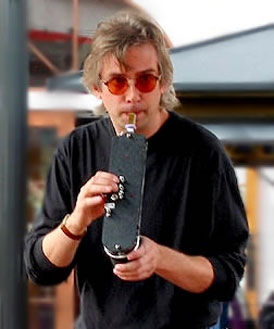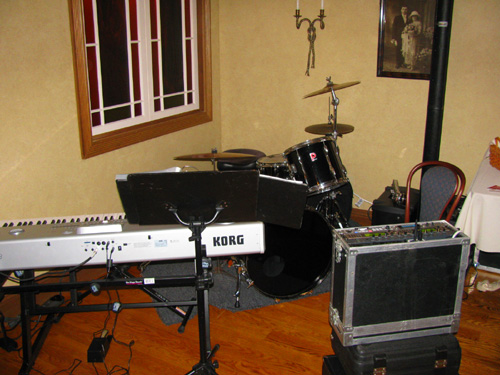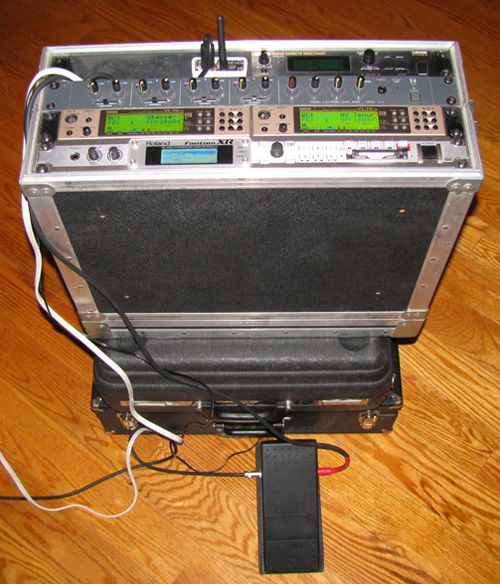Matt's
EVI Gig Rig
Oct. 2009
EVI Gig Rig
Oct. 2009

|
|
|
|
|
|
|
|
|
|

Matt's Gig Rig - October 2009
|
 Go back to Matt's Gig Rig Index
Go back to Matt's Gig Rig Index
 Go back to Matt's Gig Rig Index
Go back to Matt's Gig Rig IndexHere is my latest "Gig Rig" as of October 2009.
It's been a few years since I have updated this Gig Rig section of the website. Since the last gig rig, I have pulled one of the three VL70-m TURBOs out of my rack and replaced it with a Roland Fantom XR rack synth. The TURBO VL is superb and I still use two in the rig, but there are a few things it simply cannot do and I want to be able to do everything with my rig. So the Roland Fantom XR module gives me the added ability to do massive Brecker-style chordal layers and string ensembles and brass sections and also percussion and other sampled type sounds such as scat type vocals, keyboards, vibes and marimbas, congas, etc... The result is that this rig now represents an unbelievably powerful music making machine. It is 100% reliable, it never crashes, it has no noticeable latency, and it boots up every time immediately.
I have been working on- and using- my own wind controller soundbanks for the Roland Fantom XR for several years. These sounds have been very carefully developed over this period of time in this rig. These exciting new soundbanks have now been released commercially. Click here for complete info and demos on these Fantom XR sounds I use and sell.
Having three separate modules in the rack allows me to quickly call up and change between sounds either by sending program change commands wirelessly from the MIDI EVI or by pushing buttons on the front panel of the modules. I tend to prefer to mix on the fly as I play so I generally call up the sounds I think I might want to use in the song to be played. Then, by having my mixer at waist level, I can easily mute and unmute and mix my sound as I play. In the past I have tried to pre-program multi-module sound layers but it never works out to my liking as there are too many variables at a gig (i.e. reverb levels, eq levels for the room, other instruments in the band that I don't want to step on, etc...) So I mix live. It is a synthesist performance in every sense of the word. Also by having multiple synth modules in the rig, I won't have a gig-stopping disaster if one synth goes down. I also carry two MIDI EVI horns for this same reason.
The overall volume of the rack is controlled by a Yamaha FC9 volume pedal on the floor connected inline between the mono/sum output of my TOA D-3 mixer and the input of the Bose PAS model 1 amp. I find that I often need to control the overall volume of the rig even within a song and a volume footpedal is the quickest and most natural way to do this. The Yamaha FC9 is the best sounding and most rugged volume pedal on the market. It is highly recommended. The Bose PAS is set to its "Flat" setting selected via the switch located next to the input on the Bose (this step is important).
The rack you see below is a 4 space anvil type rack case which holds two Yamaha VL70-m's upgraded with the amazing Patchman Music TURBO VL Upgrade chip, the Roland Fantom XR Module, a Boss SE-70 Multi-effects processor, a TOA D3 Mixer, and a Midi Jet Pro wireless MIDI system. I place the rack on top of the other carrying cases bringing it right up to waist level and perfect for controlling the mixer in the performance.
![]() The
wind controller I prefer to play is a highly modified MIDI
EVI trumpet type MIDI wind controller made by Nyle
Steiner. I have modified it and added an embouchure
sensor mod of my own design which adds another MIDI controller
in response to embouchure pressure. I usually set this controller
to send Midi controller #4 (foot controller) and assign that
controller in my patches usually to add a bit of growl to the
sound. The TURBO VL sounds are already preprogrammed to do this
as are many of the sounds in the Fantom XR wind controller soundbank
I have created. I have also installed a MIDI Jet Pro Midi wireless
system inside the MIDI EVI for completely wireless operation.
The Midi Jet Pro is powered by the same 9v battery that powers
the MIDI EVI so I only have to flip one switch to turn it all
on. I have also installed much higher quality octave rollers
and stainless steel finger pads (they feel great) and modified
the horn so that the bite sensor is used for EWI type vibrato
(instead of portamento as on the the stock MIDI EVI). The portamento
sensor is now on what was the right hand 1/2 bend pinky sensor.
I also added a "bite to breath" pot that injects adjustable
amounts of tremolo into the breath signal in response to bite/vibrato
(especially great for flute and recorder type sounds). I also
designed a ring around the octave canister to make it easier
to hold the MIDI EVI without having to always worry about touching
the small thumb tack ground sensor. And finally, I wired the
trill 2 key over to the large post near the right hand pinky
so that I can play up a half step very easily (great for playing
outside jazz licks or playing in C#). The MIDI EVI has also been
prepped internally for Nyle Steiner's upcoming Version 2 OS which
adds lots of great new and innovative features. More info in
this upgrade will be forthcoming from Patchman Music here.
Since my last gig rig report I have removed the internal blue
LEDs which I had installed inside the MIDI EVI for effect. I
grew tired of the lit up effect and they shortened the battery
life a bit more than I wanted. The MIDI EVI and its internal
Midi Jet Pro all run off of a single 9 volt battery. I get INCREDIBLE
life out of this one single 9v battery which plugs into a receptacle
I designed INSIDE the octave canister! You can see the tip of
the "Coppertop" battery in the photo at right.
The
wind controller I prefer to play is a highly modified MIDI
EVI trumpet type MIDI wind controller made by Nyle
Steiner. I have modified it and added an embouchure
sensor mod of my own design which adds another MIDI controller
in response to embouchure pressure. I usually set this controller
to send Midi controller #4 (foot controller) and assign that
controller in my patches usually to add a bit of growl to the
sound. The TURBO VL sounds are already preprogrammed to do this
as are many of the sounds in the Fantom XR wind controller soundbank
I have created. I have also installed a MIDI Jet Pro Midi wireless
system inside the MIDI EVI for completely wireless operation.
The Midi Jet Pro is powered by the same 9v battery that powers
the MIDI EVI so I only have to flip one switch to turn it all
on. I have also installed much higher quality octave rollers
and stainless steel finger pads (they feel great) and modified
the horn so that the bite sensor is used for EWI type vibrato
(instead of portamento as on the the stock MIDI EVI). The portamento
sensor is now on what was the right hand 1/2 bend pinky sensor.
I also added a "bite to breath" pot that injects adjustable
amounts of tremolo into the breath signal in response to bite/vibrato
(especially great for flute and recorder type sounds). I also
designed a ring around the octave canister to make it easier
to hold the MIDI EVI without having to always worry about touching
the small thumb tack ground sensor. And finally, I wired the
trill 2 key over to the large post near the right hand pinky
so that I can play up a half step very easily (great for playing
outside jazz licks or playing in C#). The MIDI EVI has also been
prepped internally for Nyle Steiner's upcoming Version 2 OS which
adds lots of great new and innovative features. More info in
this upgrade will be forthcoming from Patchman Music here.
Since my last gig rig report I have removed the internal blue
LEDs which I had installed inside the MIDI EVI for effect. I
grew tired of the lit up effect and they shortened the battery
life a bit more than I wanted. The MIDI EVI and its internal
Midi Jet Pro all run off of a single 9 volt battery. I get INCREDIBLE
life out of this one single 9v battery which plugs into a receptacle
I designed INSIDE the octave canister! You can see the tip of
the "Coppertop" battery in the photo at right.
![]() For some gigs I like to
also bring along my modified Crumar EVI. The Crumar EVI is an
awesome instrument that has the greatest analog sawtooth oscillator
and filter ever made. Listen
to it here. When I bring it I simply plug it into the fourth
input on the TOA.
For some gigs I like to
also bring along my modified Crumar EVI. The Crumar EVI is an
awesome instrument that has the greatest analog sawtooth oscillator
and filter ever made. Listen
to it here. When I bring it I simply plug it into the fourth
input on the TOA.
The rack case only needs to have the top lid removed to access the audio cables and power cable out through the opening in the top. The bottom stays on at all times making setup very fast and easy.
The Bose PAS is my amp of choice. It is not cheap but its sound is unequalled. Newer models have come out since this model, but I have not tried them nor have I any had need to desire to change. The Bose functions as the PA and monitor and is placed behind the performer. Since it is tall (it's taller than me!), there is never a need to stoop down to hear yourself as you often do with a floor monitor. The sounds is clean and at head level. And with the waveguide design of the Bose and the way it throws sound to the back of the room, the volume level on stage is much less than it would be when using traditional type speakers. I usually bring both of the bass subs to the gig since I plug my keyboardist into it as well. I recommend at least one bass sub even for solo wind controller amplification. The bass bins make all the difference in the world. With two bass subs connected, no bass amp can beat it. In my trio, the Bose is handling the lead EVI, the keyboards, and the keyboard left hand bass. My keyboardist plays either a Korg PA1x-Pro or a Korg PA588. The entire trio goes through the Bose (except for the drums) and it sounds incredible. For small clubs and more intimate venues, this has worked incredibly well.
For more information on me and my trio visit these links:
Matt
Patchman Music
Tuesday, December 8, 2009



PATCHMAN MUSIC HOME | Wind Controller Soundbanks
| Be sure to check out the amazing Aerophone Academy Podcast co-hosted by Patchman Music's own Matt Traum and Alistair Parnell (iSax Academy) for in depth discussions and interviews on everything related to wind controllers! |


Check out the INCREDIBLE PATCHMAN TURBO VL Upgrade Chip for the Yamaha VL70-m |

This page was last updated Wednesday, August 6, 2025
Copyright ©1996-2025 PATCHMAN MUSIC, LLC, All Rights Reserved
Purchase Terms and Conditions
All trademarks are property of their respective holders

